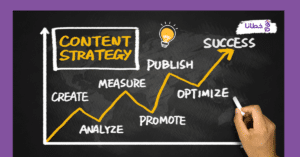table of contents
In the fast-paced world of digital marketing, content marketing is one of the most important pillars of success. Good, useful content is key to capturing audience attention, building strong relationships with them, and achieving business goals. In this article, we’ll explore a comprehensive guide to content marketing and discover together how to create unique and distinctive content.
Definition of content marketing:
Content marketing is a marketing strategy that focuses on creating and distributing valuable and relevant content to attract and engage a target audience. Rather than focusing on direct sales, content marketing aims to build long-term relationships with consumers by providing useful and valuable information.
Reviewing the digital marketing plan and its importance in content creation
I’ll provide a detailed review of a digital marketing plan and its importance in content creation. A digital marketing plan is the cornerstone of any successful marketing campaign in the digital age. This plan includes a set of strategies and tactics aimed at reaching the target audience across various digital channels.
The importance of a digital marketing plan in content creation:
1- Targeting the right audience:
- A digital marketing plan helps you accurately define your target audience and target them with relevant content.
- This ensures that your content reaches the people who will benefit from it and engage with it most.
2- Improving content performance:
- By analyzing digital data and feedback, marketing campaign content can be improved and adapted to suit audience needs.
- This contributes to increased user engagement and more effective achievement of campaign goals.
3- Enhancing digital presence:
- A digital marketing plan helps build and enhance a brand’s digital presence across various channels.
- This contributes to increased brand awareness and enhanced customer loyalty.
4- Performance measurement and continuous improvement:
- This enables adjustments and informed decisions to improve the performance of future campaigns.
- A digital marketing plan provides tools to measure campaign performance and analyze digital data.
In general, a digital marketing plan is a vital tool for creating effective and influential content, as it helps you reach the right audience, improve content performance, enhance your digital presence, and continuously measure performance.
The importance of understanding online customer behavior and motivations in creating marketing content
Understanding online customer behavior and motivations is vital to creating successful marketing content. There are several reasons why this is so important:
1- Determine the target audience:
- Studying online customer behavior helps accurately define target audiences, ensuring that content reaches the people most likely to interact with it.
- Understanding customer motivations and what interests them helps direct content to meet their needs.
2- Improving user experience:
- Understanding customer behaviors online, such as browsing paths and content interaction, enables improved content design and organization.
- This leads to improved user experience, increased engagement and retention.
3- Create appropriate content:
- Understanding customer motivations and what encourages them to engage with content helps create more relevant and engaging content.
- This increases the chances of user engagement and achieving marketing goals.
4- Predicting future behavior:
- This helps in proactive planning to create relevant content and implement effective marketing campaigns.
- Analyzing past customer behavior enables us to predict future behaviors and anticipate their needs.
5- Performance measurement and continuous improvement:
- This data enables continuous improvements to content and marketing strategies.
- Monitoring and analyzing customer behavior provides valuable data for measuring the performance of digital marketing content.
In conclusion, understanding online customer behavior and motivations is crucial for creating effective and relevant marketing content for your target audience. This understanding helps achieve digital marketing goals and enhances the success of marketing campaigns.
Understanding customer concerns and creating marketing content
Understanding customer concerns is vital to creating successful marketing content. There are several ways in which understanding customer concerns can be used to improve marketing content:
1- Identify the main concerns:
- Listen to common questions and concerns customers raise through customer service or social media platforms.
- Study customer comments and feedback to identify key concerns and issues that worry them.
2- Addressing concerns in the content:
- Provide clear and reliable answers to common questions and concerns in your marketing content.
- Include content that directly and transparently addresses customer concerns.
3- Building trust and transparency:
- Use honest and straightforward language in your content to build trust and reduce fears.
- Provide objective information and accurate facts to help allay concerns.
4- Providing support and guidance:
- Create educational and instructional content that helps customers use products or services effectively.
- Provide clear and detailed user manuals for products and services to reduce concerns about usage.
5- Engage customers and receive their feedback:
- Encourage customers to share their concerns and suggestions through feedback forms or surveys.
- Respond quickly and handle customer concerns effectively.
6- Content testing and improvement:
- Use content analytics to identify weaknesses and make continuous improvements.
- Conduct A/B tests on content to measure the effectiveness of addressing concerns.
By focusing on understanding and addressing customer concerns in marketing content, customer trust can be built and their experience improved, leading to increased engagement and conversion.
Online purchasing and content marketing
The online purchasing process plays a pivotal role in creating effective marketing content. There are several tips and practices you can follow to improve your marketing content based on understanding the online purchasing process:
1- Understanding the stages of the online purchasing process:
- Search: Provide content that helps users research and compare options.
- Awareness: Generating user interest and familiarizing them with the product or service.
- Evaluation: Providing content that helps in evaluating and deciding the appropriate choice.
- Purchase: Providing a smooth and secure online shopping experience.
- Post-purchase: Providing support and guidance to users after the purchase is completed.
2- Create appropriate content for each stage:
- Awareness stage: introductory content, short videos, awareness articles.
- Research phase: product comparisons, specification tables, subject content.
- Evaluation phase: user recommendations, interactive content, calculators, and tests.
- Purchase stage: detailed product pages, special offers, buying instructions.
- Post-purchase: User manual, customer service tips, interactive content.
3- Improving the browsing and shopping experience:
- Clearly provide shipping and delivery information and emphasize return policies.
- User-friendly website design with a natural flow of information.
- Providing fast and secure purchases with a variety of payment options.
4- Use analytics to improve content:
- Conduct A/B tests and use data to continuously improve content.
- Analyzing user behavior and preferences to improve content and experience.
- Measure key performance indicators such as conversion rates and engagement.
5- Enhancing trust and loyalty:
- Provide transparent content about policies, warranties, and services provided.
- Boost trust through customer testimonials and product reviews.
- Create loyalty programs and incentives for repeat customers.
By following these practices and steps, you can create effective marketing content that aligns with the online shopping process, improving user experience and increasing conversion rates. It’s worth noting that Khutana, a digital marketing and search engine optimization company, offers distinguished content marketing and content creation services with high professionalism. Khatana relies on experts specializing in content marketing, whom you can rely on for all digital marketing services to promote your brand and the success of your online business.
Buyer Personas and Content Marketing
Understanding buyer personas is the foundation for creating effective marketing content. Here are several tips on how to connect buyer personas to content creation:
1- Defining the target buyer personas:
- Collect information about their demographics, purchasing behaviors, needs, and challenges.
- Create hypothetical personas of typical buyers based on market data and analytics.
2- Customized content for each buyer persona:
- Develop content tailored to each buyer persona in terms of language, tone, and topics.
- Focus on addressing their unique needs and challenges.
- Use language and imagery that matches each character’s preferences.
3- Targeting buyer personas through appropriate channels:
- Determine the most appropriate marketing channels for each buyer persona, such as websites or social media.
- Personalize marketing content and messages for each channel based on each persona’s behavior and preferences.
4- Continuously measure and improve content:
- Run A/B tests and use the results to continuously improve your content.
- Monitor key performance indicators such as engagement and conversion rates.
- Use analytics to measure content performance for each buyer persona.
5- Involving buyer personas in content creation:
- Conduct interviews and listening sessions with representatives of buyer personas.
- Involve them in the content development process to ensure it is relevant to their needs.
- Ask for their feedback and comments on your marketing content.
With these practices, you’ll be able to create effective marketing content that meets the needs of your target buyer personas and achieve better marketing results.
Steps to create unique and different content:
1. Define your target audience: Starting with understanding your target audience’s needs and desires is the foundation of a successful content marketing strategy. Conduct in-depth research on your potential customers and listen to their comments and questions.
2. Create a Content Map: Use the information you gathered in the previous step to create a comprehensive content map. Identify the main topics and ideas you will cover, and how you will connect them to deliver a cohesive experience.
3. Content Production: Start creating the actual content. Write engaging and engaging texts, or produce attractive images and videos. Adding a personal and creative touch to the content is what will make it stand out and stand out.
4. Search Engine Optimization (SEO): Make sure your content is optimized for optimal search engine visibility. Use relevant keywords, optimize titles and descriptions, and link content coherently.
5. Distribute Content: Don’t just create content; distribute it through the appropriate channels. Share content on social media and post it on your blog or website.
6. Measure performance and improve your strategy: Monitor the performance of your published content and use the data to improve your strategy in the future. Learn from the experience and continue to develop your content.
In the second part of this article we will learn about:
- How to create engaging and viral marketing content?
- The difference between content writing and copywriting
- How do you start writing content?
- Ideas and types of content
- Inbound marketing
- Content types
- Content organization
- Thought leadership
Read the article here: Your Guide to Content Marketing and How to Create Engaging Marketing Content. Feel free to leave your questions and comments about the article’s topic, which is creating marketing content and writing content. In conclusion, content marketing is an effective strategy for attracting your target audience and building a strong relationship with them. By following the steps mentioned in this article, you’ll be able to create unique and distinctive content that will help you achieve your business goals. Don’t hesitate to implement this strategy and start creating content that contributes to your success.
Questions about the content creation article and your guide to content marketing 2025
What is content creation in content marketing?
In this regard, content creation is the process of creating content that resonates with your target audience and helps support your business goals. So, you’re not just creating content to express yourself here. You’re creating it with specific personas, sales stages, and key performance indicators in mind.
How do I start creating content?
Optimize your content for each social media platform.
Determine which platforms work best.
Create high-quality, engaging content.
Define your target audience.
Develop a content schedule.
Create a content library.
Understand the limitations of the content.
Set your goals.
Is content creation a skill?
Content creation is a difficult skill that effectively separates good content from great content. This skill requires not only a deep understanding of the subject matter but also the ability to express one’s ideas clearly and concisely. For many people, this skill is difficult to master.
What is an example of content creation?
Examples of content creation include things like blog posts (like the one you’re reading now), newsletters, podcasts, videos, posters, and more. Content creation in marketing often combines brand-specific messaging with general industry educational materials.
We respect and value your time... half an hour to grow your project
































